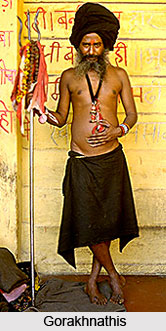 Popular legends related to the Gorakhnathi sect describe the Yogis are one of the chief divisions of the Shaivite ascetics. Lord Shiva is the ideal ascetic. He exhibits the get-up, the austerities and the powers arising from the pursuit of such activities. The Yogis are the residue of ancient Shaivite sects which began as philosophies and became ascetic orders. More particularly are they Pasupata Saivas. However, influences of decadent Buddhism are clearly indicated in the Nepalese traditions of the Gorakhnathis and both Buddhist and Tantric characteristics in the legends from West Bengal. The chief of the Saivite sects who precede the Kanphata yogis were the Pasupata, the Lakulisa, the Kalamukha, the Kapalika and the aughoris, all of which are Pasupata. The Kanphatas share many things with the earlier orders and do not differ so very much from them. The Pasupata sects, as such, have almost completely disappeared. A few Aghoris may be seen now and then. They are old Kapalikas and a few Aughars who are Kapalikas reformed under the influence of Kabir.
Popular legends related to the Gorakhnathi sect describe the Yogis are one of the chief divisions of the Shaivite ascetics. Lord Shiva is the ideal ascetic. He exhibits the get-up, the austerities and the powers arising from the pursuit of such activities. The Yogis are the residue of ancient Shaivite sects which began as philosophies and became ascetic orders. More particularly are they Pasupata Saivas. However, influences of decadent Buddhism are clearly indicated in the Nepalese traditions of the Gorakhnathis and both Buddhist and Tantric characteristics in the legends from West Bengal. The chief of the Saivite sects who precede the Kanphata yogis were the Pasupata, the Lakulisa, the Kalamukha, the Kapalika and the aughoris, all of which are Pasupata. The Kanphatas share many things with the earlier orders and do not differ so very much from them. The Pasupata sects, as such, have almost completely disappeared. A few Aghoris may be seen now and then. They are old Kapalikas and a few Aughars who are Kapalikas reformed under the influence of Kabir.
In South India Lakulin or Lakulisa is said to be the original teacher of the order. Lakula was a general term by which Siva sects were called, another was Pasupata. Later arose out of this original Lakulisa-Pasupata sect the three systems, Pasupata, Kalamukha and Kapalika. These sects were more extreme and less rational than the other Shaivites. The Lakulisa are a sub-order of the Pasupata. The word Lakula or Nakula, means `club` and the reference is to the Lord-of-the-Club or the Lord-Bearing-a-Club.
The Kalamukhas are closely associated with the Lakulisas; in fact they were the `black friars` who, as exponents of the Lakulisa doctrines were responsible for its spread in the south during the eleventh and twelfth centuries. This sect is still active. The members seem to lie extremely horrible in character. They worship Lord Shiva Mahakala (the great destroyer) or as Kapalabhrat (skull-wearer), Kapalin is Bhairava, the most terrible form of Lord Shiva. With these are sometimes associated the possibly more revolting Aghori. The latter at least, are cannibalistic. Some modern Sections of the cult are of recent origin. However, the Kapalikas (`wearers of skulls`, they wore skulls around their necks) were known fairly early.
A general description of the Kapalikas states that they went about naked, wore a cap while travelling, smeared their bodies with funeral ashes, were armed with a trident or sword, carried a hollow skull for a cup or begging bowl, were half-intoxicated with spirits which they drank from the hollow skull, were known to commit acts of violence; their garments (when they wore them) were of patch-work, they slept on the ground, and wore a rosary of rudraksa seeds. They offered human sacrifices to Chamunda in order to obtain magic powers, and often resorted to tricks to ensnare victims. Dust from their feet was supposed to cure diseases and water from the washing of their feet drove away demons. The powers which they acquired included the ability to fly through the air. Their wits were sharpened by the use of wine, eating disgusting food, and the embrace of the Shakti of Bhairava.
The Kapalikas have merged into other sects, particularly into the Kanphatas, but all have been contemporary sects for some time. Thus, from the foregoing accounts it is can be specified that the predecessors of Gorakhnathis have much in common. A composite picture from these descriptions would exhibit many traits in the sect of the Kanphatas.




















